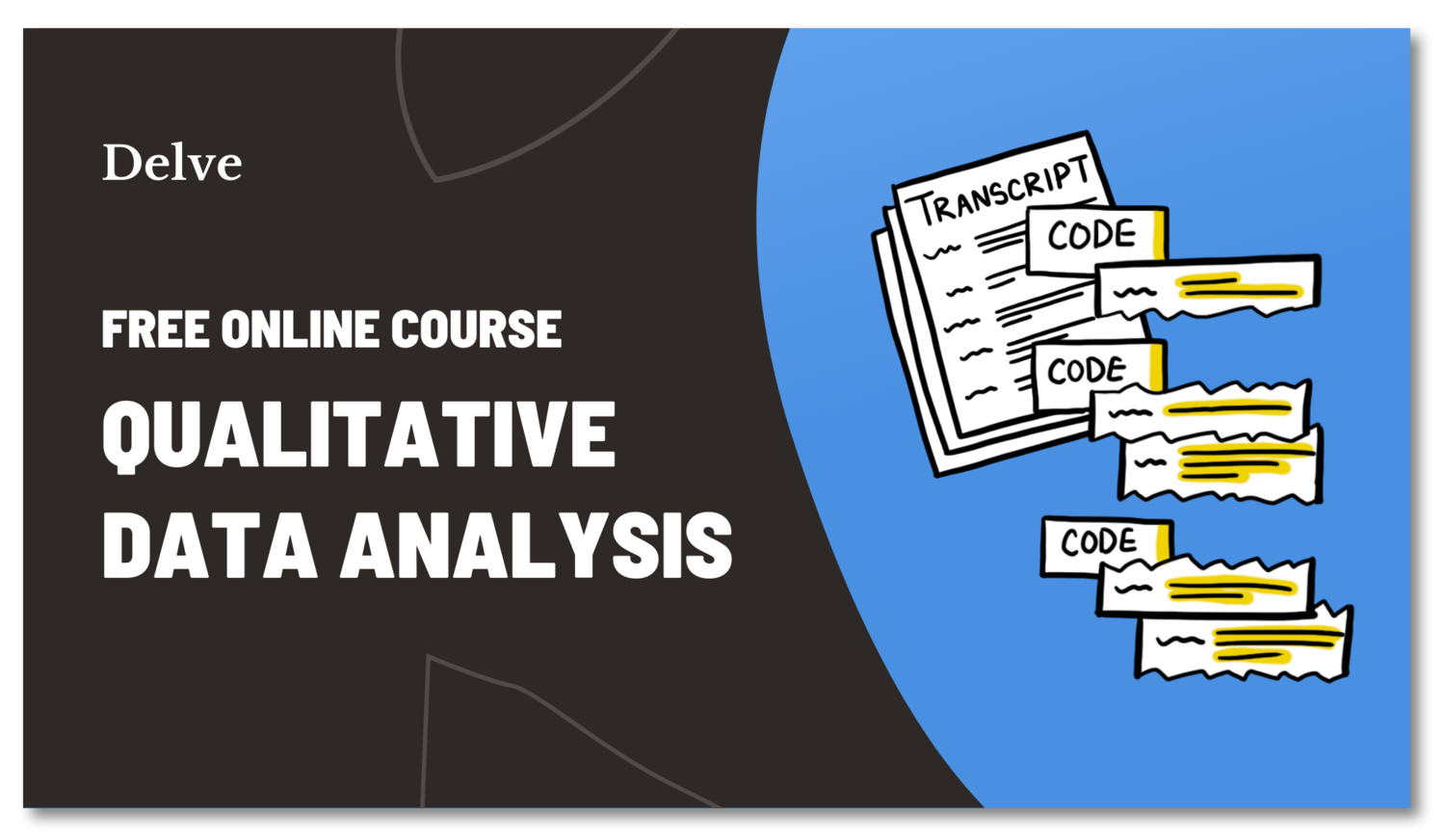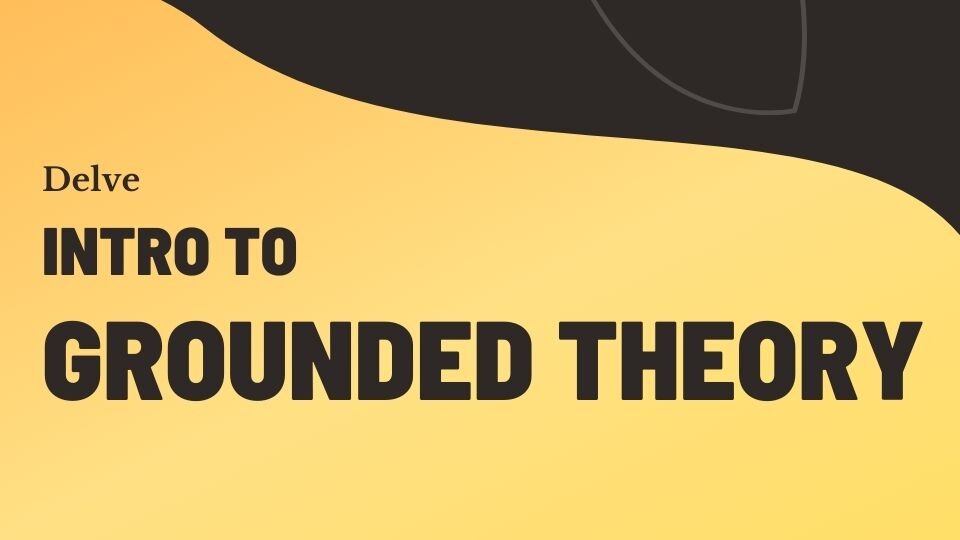How to Show You Know Historical Theory

What is grounded theory?
Grounded theory is a qualitative method that enables you to written report a particular phenomenon or procedure and detect new theories that are based on the collection and analysis of real world information.
Unlike traditional hypothesis-deductive approaches of inquiry, where yous come up with a hypothesis and so effort to evidence/disprove it, grounded theory is an anterior arroyo where new theories are derived from the information.
The process of information collection, data assay, and theory development happen in an iterative procedure. Iterative data collection and analysis occurs until you accomplish theoretical saturation, the indicate at which additional data adds no boosted insight into your new theory.
When should you use grounded theory?
Y'all should consider using grounded theory when there is no existing theory that offers an explanation for a phenomenon that you are studying. It can likewise be used if there is an existing theory, but information technology is potentially incomplete every bit the information used to derive that theory wasn't nerveless from the group of participants that you programme on researching.
Benefits of using grounded theory
Findings accurately represent existent world settings
The theories you lot develop using grounded theory are derived straight from existent world participants in real world settings using methods similar in depth interviews and ascertainment, then your findings will more accurately correspond the real world. This is in dissimilarity to other research approaches that occur in less natural settings like enquiry labs or focus group tables.
Findings are tightly connected to the data
Considering grounded theory primarily relies on collected data to determine the terminal consequence, the findings are tightly connected to that data. This is in contrast to other enquiry approaches that rely more than heavily on external research frameworks or theories that are farther removed from the data.
Cracking for new discoveries
Grounded theory is a stiff, inductive inquiry method for discovering new theories. You don't go in with any preconceived hypothesis most the outcome, and are non concerned with validation or clarification. Instead, you allow the data you collect to guide your analysis and theory creation, leading to novel discoveries.
Offers strategies for analysis
The process of grounded theory describes specific strategies for assay that can be incredibly helpful. While grounded theory is a very open up ended methodology, the assay strategies enable you to stay structured and analytical in your discovery procedure.
Data drove and assay are streamlined
Data collection and analysis are tightly interwoven. As you collect data, you analyze it, and as yous learn from analysis, you continue to collect more data. This helps ensure that the information you lot collect is sufficient plenty to explicate the findings that arise from analysis.
Buffers against confirmation bias
Because information collection and analysis are tightly interwoven, y'all are truly following what is emerging from the data itself. This provides a great buffer against confirming preconceived beliefs about your topic.
Download Free Grounded Theory Guide
Want to learn how to do Grounded Theory? Submit your email to request our free grounded theory guide with tips on how to get started with your ain thematic analysis.
Limitations of grounded theory
Difficulty recruiting
Grounded theory relies on an iterative recruiting process called theoretical sampling where you lot continuously recruit and conduct new rounds of interviews with new participants and previous participants while you analyze data. The recruiting criteria besides evolves and changes based on what you lot learn. Because the recruiting is non predefined, it can be challenging to continuously find the right participants for your written report.
Time consuming to collect data
There is no fashion to know ahead of time how much information you will demand to collect, so you lot demand to be flexible with your fourth dimension. With grounded theory, y'all continuously collect and clarify information until y'all achieve theoretical saturation, which is the bespeak at which new data does non contribute new insight to your evolving theory. This means that you are probable to conduct many rounds of data collection before your theory is complete.
Challenges in analysis
Data analysis occurs on a rolling basis and involves making constant comparisons between different excerpts of data. Information technology tin can be challenging to keep rail of your comparisons and findings every bit you lot become. It can be helpful to employ a qualitative data analysis software similar Delve to assist you stay organized during your assay.
History of grounded theory

Grounded Theory (GT) was starting time developed by Sociologist Barney Glaser and Anselm Strauss. During this catamenia, they criticized the predominant approach to qualitative enquiry, which they constitute to exist very limited. Qualitative studies at this time were following traditional methods which basically involved coming upwardly with a hypothesis and conducting inquiry to validate information technology.
Glaser and Strauss pioneered a new methodology for discovering theory by taking an inductive approach to qualitative inquiry. They formally presented their newly adult research method by publishing Discovery of Grounded Theory: Strategies for qualitative research (1967).
Since then, various evolutions of grounded to theory emerged, including Basics of Qualitative Research: Grounded Theory Procedures and Techniques (1990) by Strauss and Corbin. This shifted from the concept of the natural emergence of theory by designing an analytical coding framework for generating theories from data systematically.
In 1990s, Kathy Charmaz published a new approach chosen constructivist grounded theory, and argued that neither data nor theories are discovered but are synthetic through the researchers' past and nowadays experiences.
Read more about the history of grounded theory here.
Watch Webinar
Meet the step by pace procedure of grounded theory.
How exercise yous do grounded theory research?
This is an overview of how you can approach the process of grounded theory. Know that this isn't the just way to arroyo grounded theory, but just a collection of tips and processes derived from various grounded theory resource that y'all tin apply to inspire your own grounded theory study.
Notation: We adjusted some terminology and linguistic communication from the original grounded theory papers in order to make this guide as applied every bit possible for anybody aiming to apply grounded theory with qualitative data assay software.
If y'all wish to gain more depth in your grounded theory knowledge, we highly encourage you to read the original papers from Glaser, Strauss, Corbin and Charmaz, which we link to in the references at the bottom of this page.
Steps for grounded theory
-
Determine initial research questions
-
Recruit and collect data (theoretical sampling)
-
Break transcripts into excerpts (open up coding)
-
Group excerpts into codes (open coding)
-
Grouping codes into categories (axial coding)
-
Clarify more excerpts and compare with codes
-
Repeat steps 2-6 until yous achieve theoretical saturation
-
Define the central idea (selective coding)
-
Write your grounded theory
Notation: Approach your enquiry iteratively
Grounded theory is not a linear process where y'all collect data, clarify it, and then you're done. It is an iterative inquiry methodology that involves cycling through the steps iteratively. Part of what made Grounded Theory revolutionary was that information technology mixed information collection with analysis. Information technology emphasized going back to the field fifty-fifty later on conducting some analysis. You volition recruit some participants, gather information and analyse information technology, and become dorsum into the field over again with a different recruiting strategy and focus of inquiry. And so you'll incorporate those findings into further rounds of analysis. Grounded theory is deliberately cyclical in nature.
i. Determine initial research questions
Start off with your initial research questions. Have an idea for what phenomenon you are trying to explain. These initial questions will aid guide your first steps in recruiting and data assay but know that the questions may evolve equally y'all observe and acquire more from the information you collect.
2. Recruit and collect data using theoretical sampling
With grounded theory, recruiting participants is iterative. Instead of pre-determining a specified recruiting criteria ahead of time, you will do what is chosen theoretical sampling. With theoretical sampling, you beginning with recruiting a small grouping of participants loosely based on your initial research questions.
Once y'all have some data, such as recordings from in depth interviews, prepare that information for analysis by turning them into transcripts.
After you lot exercise some initial analysis of that data, which we detail in the post-obit steps, you use what yous learned from that assay to determine who to recruit next.
Read more about how to exercise theoretical sampling here.
iii. Break upward transcripts into excerpts using open coding
Subsequently you have collected some data, such as transcriptions from interviews*, you tin can brainstorm open coding. Open coding is when you lot accept your transcripts, and break it into private excerpts. Then, have the excerpts and continuously compare and contrast them with other excerpts This act of comparison is office of a core grounded theory method called constant comparative method, which you will employ throughout diverse phases of your analysis.
Notice similarities and differences betwixt excerpts.
-
Compare dissimilar excerpts from the same person
-
Compare similar excerpts that occur between unlike people
-
Compare different peoples' experiences inside similar excerpts
-
Compare excerpts as they differ from ane mean solar day to the next
For example, in a study nearly the COVID-nineteen lockdown in New York City, you may read an excerpt that describes a person having trouble sleeping. Yous should take that excerpt and compare that to other people who also experienced trouble sleeping. Accept notice of any similarities or differences between those experiences.
*For the purpose of this article we will refer to nerveless data every bit 'interview transcripts' and 'transcript excerpts', but you tin can use any blazon of qualitative data such as observations, notes, etc.
Read more about open coding here.
Reflect on thoughts and contradictions by writing memos during analysis
Reflect on your analytical thoughts and write them down in the course of memos. Recollect of memos as your "notes to self" to record your railroad train of thought, and to go on a record of your reflections. The deed of writing memos tin be a peachy style to reverberate on whatever contradictions you lot observe in the information. Your memos may eventually turn into the edifice blocks for your theory.
Learn more about analytical memos hither.
4. Group excerpts together into codes using open up coding
As you make comparisons between excerpts of information, wait for sets of excerpts that stand for the same central thought or concept, and group them together. You can use a "code" to encapsulate these groups of excerpts. Codes are like tags or labels that are assigned to excerpts of text.
For case, suppose you were comparing these excerpts:
-
"I only kept watching the news, even late into the dark. And found myself having a harder and harder fourth dimension falling asleep"
-
"Definitely was experiencing indisposition for a while…"
-
"I was so worried. The thoughts kept spinning in my caput and I'd lay there with my eyes open up for hours"
All of these represent the concept of "trouble sleeping". So if you are using qualitative data analysis software, yous can create a code called "trouble sleeping" and bring all of these excerpts nether the code "trouble sleeping".
Once you have a code called "trouble sleeping", all future excerpts that you analyze should non only exist compared to other excerpts, but they should likewise exist compared to the code "trouble sleeping", and any other lawmaking that yous accept.
Qualitative assay doesn't have to be overwhelming
Take Delve's complimentary online form to acquire how to find themes and patterns in your qualitative data. Become started here.

5. Group codes into categories using centric coding
As y'all gradually develop a list of codes that bring together sets of excerpts, yous should also begin to likewise compare codes with other codes. When you find connections between multiple codes, yous tin can group them together into a 'category'. This pace of grounded theory is called 'axial coding', where you detect the axes that connect various codes together. If y'all are using qualitative data analysis software, these categories are represented by a series of 'nested codes' which are stacked in a bureaucracy.
For case, in the previous stride, we had a code called "problem sleeping". Suppose you lot besides had another code, "experiencing panic attacks". Y'all may observe that there is a relationship between these 2 codes and they can exist grouped under a category called "Reacting negatively to the pandemic with anxiety".
In qualitative data analysis software, this bureaucracy would wait like this:
-
[Reacting negatively to the pandemic with anxiety]
-
[Trouble sleeping]
-
[Experiencing panic attacks]
-
If you would like a more structured approach to finding means to group codes together, you lot can learn more than near Corbin and Strauss's coding paradigm, which you can read more almost here.
6. Analyze more than excerpts using constant comparative method
Recall, grounded theory is a cyclical process! Fifty-fifty after you have created lists of codes, and grouped codes into categories, you should continue to analyze boosted interview transcripts, and compare the new excerpts to your existing codes categories. Read more than about abiding comparative method here.
Equally you make comparisons betwixt your new excerpts to your codes and categories, your excerpts will by and large exercise 1 of three things: contradict, aggrandize upon, or support your existing codes and categories. Here's what you should consider in each scenario:
-
Contradiction: If your new excerpt contradicts a code, this may be a sign that y'all demand to adjust that code or change it. Information technology likely also means that yous need to go back to stride two and conduct more rounds of data collection through theoretical sampling to help explicate the contradiction. Read more than nigh how to handle contradictions in our commodity on negative case analysis.
-
Expansion: If your new excerpt expands upon your lawmaking, either past adding more description or explaining more facets of your code, this is a good sign that y'all are standing to learn more and it means that you should keep to collect and clarify data until your new excerpts just support your codes rather than aggrandize upon them.
-
Support: If your new excerpt mostly supports your code without adding boosted data, this means that yous may have reached theoretical saturation, which is the point at which more than excerpts do non contribute whatsoever additional insight into your codes and you tin can move onto a after stage of your enquiry.
With grounded theory, your goal is not to lawmaking or keep rails of everything that occurs in every extract. For example, one time yous plant the category that people under COVID-nineteen lockdown were [Reacting negatively to the pandemic with anxiety], you don't demand to become back and code every single extract that refers to that category. However, if y'all come up across an extract where a person did non [react negatively to the pandemic with anxiety], this may open up the doors to expanding upon or changing your category.
7. Continue collecting data and analyzing until you reach theoretical saturation
With these iterative steps, when practise you know that y'all have analyzed enough? How do yous know when you should stop recruiting or analyzing additional data?
With grounded theory, you want to continue until yous reach the point where additional transcript excerpts practise not expand upon your codes and categories. In other words, if you lot are learning the aforementioned matter over and over over again even with additional excerpts, that means that your codes and categories have become 'theoretically saturated'. The excerpts you have collected and so far address all relevant aspects of your codes and categories and there is no need to pursue further data collection or analysis for your particular codes and categories.
8. Define the cadre category using selective coding
Once you feel you have reached theoretical saturation in your codes and categories and so far, it is fourth dimension to pull your findings together with selective coding. With selective coding, y'all connect all your codes and categories together nether one core category.
This core category represents the cardinal thesis of your research, and is the core idea behind your theory. This core category tin be an existing category that yous derived earlier, or information technology can be a new category that you lot derive from all your existing findings then far.
This core category will be the basis for your new grounded theory.
For example, if you have a list of categories like
-
[Reacting negatively to the pandemic with anxiety]
-
[Feeling loneliness during lockdown]
-
[Virtual and in person socializaton]
-
[Mental health pre-COVID-19]
-
[Electric current housing set up not suited for lockdown]
You may use selective coding to ascertain the key, core category every bit [Access to lockdown suitable housing, mitigated COVID-19 Anxiety during lockdown], to link all your existing categories together.
Learn more than about selective coding hither.
9. Write your grounded theory
In one case you have determined your cadre category through selective coding, and are confident that y'all have reached theoretical saturation, it is fourth dimension to construct your new theory.
Assemble together your coded data, and series of memos and utilise them to describe your new theory.
-
State your new theory in just a couple words or sentences
-
Ascertain the limits or boundary of your theory
-
Summarize and write a description of your theory
-
Use your coded data to validate the points y'all suggest in your theory
-
Write an accurate argument of what was studied, and construct your theory in a form that other researchers can use.

Spotter Webinar
Acquire how to discover new theories based on the drove and analysis of real-world qualitative information in this free webinar.
Spotter webinar.
You tin do your grounded theory coding by manus, using word processors and spreadsheets such as Microsoft Give-and-take and Microsoft Excel, or use Computer Assisted Qualitative Data Analysis Software such as Delve. There are pros and cons to each approach, and you should choose one based off what is most appropriate for your enquiry. Read more than about how to code qualitative data.
Try Delve, Software for Qualitative Coding
Online qualitative research software such as Delve can help streamline how y'all're coding your qualitative coding. Endeavor a xiv twenty-four hour period free trial of Delve.
Grounded theory coding using pen and paper
You tin can use simple tools like pen, paper, pair of scissors, and highlighters to lawmaking past hand. Only print out your transcripts, and do open coding by cutting up the transcripts into individual excerpts. The next steps are done by organizing those papers into piles, as you create your codes and categories.
This is a great way to organize data with your easily, but can exist come very time consuming, especially with large data sets. And it can be challenging to keep track of your comparisons since you'd take to keep runway of all your sheets of paper.
Grounded theory coding using a word processor
If you lot decide to use a word processor such equally Microsoft Word or Google Docs, practise your open up coding round by highlighting excerpts. You can and then lawmaking past adding comments to those excerpts. To create category, copy and paste excerpts into dissimilar documents labeled by the category name. This is a adept way to continue your analysis in a digital format, but tin feel cumbersome to continually re-create and paste your
Grounded theory coding using qualitative data analysis software

Software such as the Delve qualitative data analysis software are designed to back up processes like grounded theory. You can use Delve to help go on track of your excerpts and codes, and organize your thoughts as y'all do constant comparisons. The digital interface will assist you manage large data sets and keep rail of the many comparisons y'all will do. Additional features such as demographic filters and the ability to search across transcripts can too help streamline your grounded theory process.
Endeavor the Delve Software for Qualitative Coding
Online software such as Delve tin can assist streamline how you're coding your qualitative coding. Endeavour a free trial or watch a demo of Delve.
References
-
Corbin, J., & Strauss, A. (1990). Grounded theory research: Procedures, canons, and evaluative criteria. Qualitative Sociology, 13, 3-21.
-
Charmaz, Kathy (2006). Constructing Grounded Theory: A practical guide through Qualitative Assay. Thousand Oaks, California: Sage.
-
Glaser, B. Grand., & Strauss, A. L. (1967). The Discovery of Grounded Theory: Strategies for Qualitative Inquiry.
boehmreckessequod.blogspot.com
Source: https://delvetool.com/groundedtheory
0 Response to "How to Show You Know Historical Theory"
Post a Comment